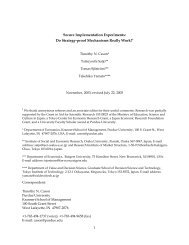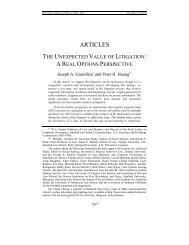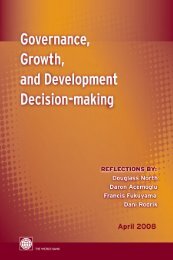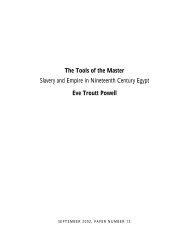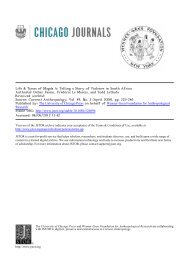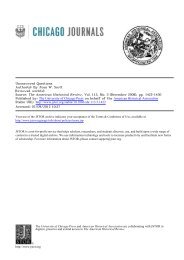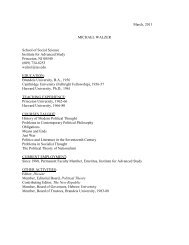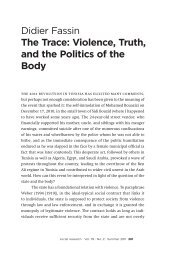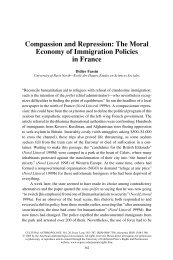Peter H. Huang Harold E. Kohn Chair Professor of Law James ...
Peter H. Huang Harold E. Kohn Chair Professor of Law James ...
Peter H. Huang Harold E. Kohn Chair Professor of Law James ...
You also want an ePaper? Increase the reach of your titles
YUMPU automatically turns print PDFs into web optimized ePapers that Google loves.
Emotional Impact Analysis<br />
decisions that government agencies or companies make. 73 Empirical research based upon data from the<br />
European Union revealed that institutional trust in law positively impacts people’s subjective well-<br />
being. 74 Thus, EIA should analyze and acknowledge not only emotions related to substantive outcomes,<br />
but also such emotions related to procedural or process considerations as emotional difficulties that<br />
individuals and groups <strong>of</strong> people have in facing and making certain types <strong>of</strong> trade<strong>of</strong>fs. 75<br />
This Article advocates that securities and financial regulators can and must incorporate<br />
consequences that securities and financial regulations have upon the affect, emotions, feelings, and moods<br />
<strong>of</strong> investors, other financial markets participants, and even people who are not participants in financial or<br />
securities markets. 76 EIA advocates that regulators consider emotional impacts that alternative<br />
regulations have upon both emotions themselves and consequences <strong>of</strong> emotions on economic and<br />
financial variables. Such analysis is more challenging than traditional CBA but researchers in psychology<br />
and neurosciences have successfully analyzed, measured, and studied changes in emotions. Ex ante CBA<br />
<strong>of</strong> environmental, health, and safety regulations is based upon monetary measures <strong>of</strong> benefits and costs, 77<br />
determined via revealed preference techniques, such as hedonic pricing methodology, 78 or stated<br />
preference techniques, such as contingent valuation methodology. 79 EIA shares its emphasis on actual<br />
73 Jonathan Baron & Andrea D. Gurmankin Levy, Cost-Benefit Analysis Can Increase Trust in Decision Makers,<br />
available at http://www.sas.upenn.edu/~baron/cba.html.<br />
74 John Hudson, Institutional Trust and Subjective Well-Being across the EU, 59 KYKLOS 43 (2006).<br />
75 See generally MARY LUCE FRANCES ET AL., EMOTIONAL DECISIONS: TRADEOFF DIFFICULTY AND COPING IN<br />
CONSUMER CHOICE (2001).<br />
76 See e.g., Patric Andersson & Richard Tour, How to Sample Behavior and Emotions: A Psychological Approach<br />
and an Empirical Example, 26 IRISH J. MGMT. 92 (2005) (describing an experience sampling method pilot study <strong>of</strong><br />
day-traders); and Andrew W. Lo et al., Fear and Greed in Financial Markets: A Clinical Study <strong>of</strong> Day-Traders, 95<br />
AM. ECON. REV. 352 (2005) (finding a correlation between more intense emotional reactions to monetary gains or<br />
losses and significantly worse performance among day-traders). See generally JOCELYN PIXLEY, EMOTIONS IN<br />
FINANCE: DISTRUST AND UNCERTAINTY IN GLOBAL MARKETS (2004).<br />
77 ANTHONY E. BOARDMAN ET AL., COST -BENEFIT ANALYSIS: CONCEPTS AND PRACTICE 3 (3d ed. 2006)<br />
(differentiating between ex ante CBA and ex post CBA).<br />
78 See generally Daniel McFadden, The New Science <strong>of</strong> Pleasure: Consumer Behavior and the Measurement <strong>of</strong><br />
Well-Being, Frisch Lecture, Econometric Society World Congress, London (Aug. 20, 2005) (revised Oct. 5, 2005),<br />
available at http://emlab.berkeley.edu/users/webfac/dromer/e237_f05/mcfadden.pdf. See e.g., PATRICK BAYER ET<br />
AL., MIGRATION AND HEDONIC VALUATION: THE CASE OF AIR QUALITY, NAT’L BUREAU OF ECON. RES. WORKING<br />
PAPER NO. 12106, available at http://www.nber.org/papers/w12106 (critiquing standard hedonic techniques for<br />
estimating value <strong>of</strong> local amenities because those methods assume that households move freely among locations).<br />
79 See e.g., Kenneth J. Arrow et al., Report <strong>of</strong> the NOAA Panel on Contingent Valuation, 58 FED. REG. 4601 (1993);<br />
and Dollar-Based Ecosystem Valuation Methods: Contingent Valuation Method, available at<br />
http://www.ecosystemvaluation.org/contingent_valuation.htm.<br />
12



